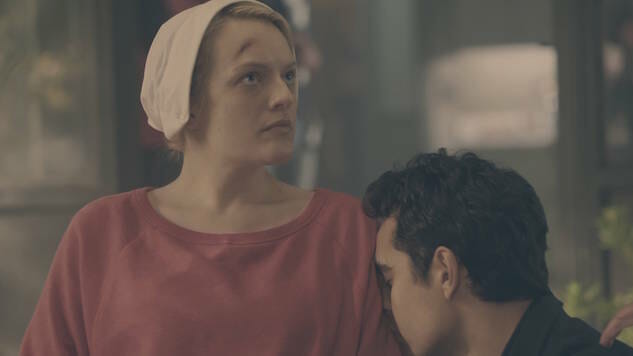The Handmaid’s Tale Season Finale Plants the Seeds of Revolution
(Episode 1.10)
George Kraychyk/Hulu
Of all the harrowing, distressing and downright terrifying moments that we’ve witnessed during the first season of The Handmaid’s Tale, the creators waited until the finale to give us the worst of them. And, no, it’s not the sight of a man having his hand surgically removed as punishment for his evil deeds of lust and coveting another woman. It was the sight of Offred (Elisabeth Moss) casting her eyes on her daughter for the first time since they were separated. At that moment, she’s stuck in the back of a car, locked in by Mrs. Waterford (Yvonne Strahovski). Offred’s joy turns to agony as she tries desperately to break out, or at the very least be heard by her little girl. No such luck. She is truly trapped.
That’s likely not the scene the creators of the series want to be the big moment of the Season One finale. The idea, it would seem, was for us to focus instead on Offred’s big moment during The Salvaging, when she dramatically—and in slow motion, natch—drops the stone with which she’s meant to be hurting Ofdaniel (Madeline Brewer). Or the proud march down the streets (again in slo-mo) by the Handmaids to the tune of a Nina Simone song. They looked great, but they smacked of a kind of desperation that befalls many prestige TV series: They’re curdled with the kind of hubris and vanity that many shows give over to, which savvy viewers can spot a mile away.
What I won’t forget is Offred screaming her heart out at the locked doors and thick glass of the car. Or, face pressed close against the glass barrier keeping her and the driver’s seat separated, spewing the kind of righteous anger and nasty insults that she never would have dared before. That’s the face of every parent trying to understand why NBC would give a platform to a conspiracy theorist toad like Alex Jones… on Father’s Day. Don’t you dare to get between a mother and her child. Hell awaits.
The rest of the hour sticks to a simple but potent theme: reminding us just how much power the women in Gilead still have. Sometimes they use it for nefarious means, like Mrs. Waterford torturing Offred with a glimpse of her child or Commander Warren’s wife demanding the steepest punishment possible for his crimes. Mostly, though, the women in this show are realizing how they can wield an upper hand, even when they’re taking blows to the face.
-

-

-

-

-

-

-

-

-

-

-

-

-

-

-

-

-

-

-

-

-

-

-

-

-

-

-

-

-

-

-

-

-

-

-

-

-

-

-

-








































